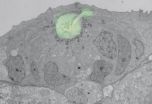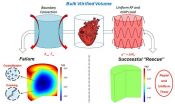Sea turtles' first days of life: A sprint and a ride towards safety
Scientists follow hatchlings from Cape Verde with tiny acoustic transmitters
2014-10-23
(Press-News.org) Loggerhead turtles (Caretta caretta) from Cape Verde start their life with a swimming sprint and a ride on favourable ocean currents. In this way, they escape quickly from predator-rich coastal areas and make their way to the safer open ocean where they spend several years feeding and growing. In this study, tiny acoustic transmitters provided direct insight into these pathways for the first time. "Thanks to the new technology we can start to fill in key information gaps about the so-called 'lost years' Dr. Rebecca Scott states. Funded by the Kiel Cluster of Excellence "The Future Ocean", the marine biologist coordinated a joint study of GEOMAR Helmholtz Centre for Ocean Research Kiel, the Turtle Foundation and the School of Biological and Chemical Sciences at the Queen Mary University of London.
"Scientists call this early life phase the 'lost years', because they were not able to follow new-born sea turtle hatchlings very far. Hatchlings essentially disappear into the sea until many years later when the lucky survivors return to where they born to breed", Dr. Scott says. But with new techniques like nano-tags and ocean models we are able to see where the tiny young animals go. This is important because the dispersal experiences of hatchlings drive the development of their behaviours into adulthood. The more we understand about the biological and physical determinants of their dispersal and swimming behaviours, the easier we can protect this endangered species."
In cooperation with the Turtle Foundation at Boa Vista, Cape Verde, the scientists collected hatchlings from two beaches in the northwest and southern tip of the island. Acoustic transmitters with a five millimetres wide and twelve millimetres long streamlined shape that weigh 0,4 grams in water were glued onto the shell of eleven hatchlings. The turtles were then followed at sea using a boat and acoustic receiver for up to eight hours and 15 kilometres. In addition, the swimming behaviour of 16 hatchlings were monitored in "hatchling swimming pools" for several days using data loggers made by engineers at GEOMAR. The turtles swam continuously during their first 24 hours after hatching and then switched to a pattern of activity at daytime and inactivity at night.
Due to the close proximity of offshore currents in this region, it seems the Cape Verdean hatchlings can sleep more at night than hatchlings from other places. For example in America, different research groups have shown that they would have swim a lot more to reach offshore currents", Dr. Scott explains. "Deep oceanic water and favourable currents, which then determined the travel directions and speeds of our Cape Verdean turtles are situated very near to their nests. Therefore, it is very beneficial for turtles if local oceanic conditions drive the evolution of swimming behaviours that are unique to different nesting locations to ensure their best survival outcomes. It seems that turtles are born with these unique locally adapted behaviours."
Finally, because larger animals kept swimming for a longer time than smaller individuals, a larger body size is thought to be a good sign of fitness. "But there is some evidence emerging that higher nest temperatures may reduce the size of hatchlings. Therefore, it might be possible that global warming decreases the fitness of the sea turtles by threatening them in more subtle ways than just obvious dangers like the loss of nesting beaches", Dr. Scott assumes.
INFORMATION:
Original publication:
Scott, R., Biastoch, A., Roder, C., Stiebens, V. A. and Eizaguirre, C., 2014: Nano-tags for neonates and ocean-mediated swimming behaviours linked to rapid dispersal of hatchling sea turtles. Proc. R. Soc. B., 218, 20141209, doi:10.1098/rspb.2014.1209
Links:
http://www.geomar.de GEOMAR Helmholtz Centre for Ocean Research Kiel
http://www.futureocean.org Cluster of Excellence "The Future Ocean"
http://www.turtle-foundation.org Turtle Foundation
http://www.sbcs.qmul.ac.uk The School of Biological and Chemical Sciences at the Queen Mary University of London
Images:
Images are available for download at http://www.geomar.de/n2124-e
Contact:
Rebecca Scott (GEOMAR, FB3-EV), Tel.: +49 431 600-4569, rscott@geomar.de
Maike Nicolai (GEOMAR Communication & Media) Tel.: +49 431 600-2807, mnicolai@geomar.de
ELSE PRESS RELEASES FROM THIS DATE:
2014-10-23
From basketball to handball, rugby to American football, teams in a variety of sports huddle together to agree tactics in secret. Cells, too, can huddle to communicate within a restricted group, scientists at the European Molecular Biology Laboratory (EMBL) in Heidelberg, Germany, have found. The study, published today in Nature, is the first demonstration that the way cells organise themselves influences their ability to communicate. The researchers propose that this strategy, which they discovered in developing zebrafish, could be much more widespread, influencing processes ...
2014-10-23
Successful techniques for cryopreserving bulk biomaterials and organ systems would transform current approaches to transplantation and regenerative medicine. However, while vitrified cryopreservation holds great promise, practical application has been limited to smaller systems (cells and thin tissues) due to diffusive heat and mass transfer limitations, which are typically manifested as devitrification and cracking failures during thaw. Here we leverage a clinically proven technology platform, in magnetically heated nanoparticles, to overcome this major hurdle limiting ...
2014-10-23
Narrowband or hyperspectral imaging is a valuable technique used in planetary science for characterizing surfaces and surrounding environments. For example, it can be used to spatially map molecular species of interest on the surface of a solid or icy body, or to sound to different depths in a giant planet atmosphere. However, conducting narrowband or hyperspectral imaging of solar system targets from a balloon-borne platform presents several technical challenges, including mechanical failures and power requirements. These risks can be mitigated with the use of an electronically ...
2014-10-23
Amsterdam, October 23, 2014 - Herbal medicines such as licorice, Indian rennet and opium poppy, are at risk of contamination with toxic mould, according to a new study published in Fungal Biology. The authors of the study, from the University of Peshawar, Pakistan say it's time for regulators to control mould contamination.
An estimated 64% of people use medicinal plants to treat illnesses and relieve pain. The herbal medicine market is worth $60 billion globally, and growing fast. Despite the increasing popularity of herbal medicine, the sale of medicinal plants is mostly ...
2014-10-23
Needham, MA.–JBJS Case Connector, an online case journal published by the Journal of Bone and Joint Surgery, has issued a "Watch" regarding concerns over flexible reamer breakage during anatomic single-bundle ACL reconstruction. Flexible reamers help surgeons achieve optimal femoral-tunnel parameters, but they are prone to breakage in certain situations, as the "Watch" article explains.
This "Watch" is based largely on a report published in the October 22, 2014 issue of JBJS Case Connector by Lee, et al., examining two cases of single-bundle anatomic ACL reconstruction ...
2014-10-23
PROVIDENCE, R.I. [Brown University] — Pay attention to the implication of these new research results: People who pay more attention to their feelings and experiences tend to have better cardiovascular health.
As noted more precisely in a new study in the International Journal of Behavioral Medicine, researchers at Brown University found a significant association between self-reported "dispositional mindfulness" and better scores on four of seven cardiovascular health indicators, as well as a composite overall health score. Dispositional mindfulness is defined as ...
2014-10-23
A study led by the researcher at the Institute of Biomedical Research (IDIBELL), Isabel Fabregat, could serve to select patients with hepatocellular carcinoma unresponsive to most frequently used drug in liver cancer: sorafenib. The study, published in the International Journal of Cancer describes how tumor cells that have a less differentiated phenotype (mesenchymal) and expresses CD44, do not respond to Sorafenib action.
Difficult treatment
Hepatocellular carcinoma is one of the cancers with the worst prognosis and more difficult treatment. Surgery is only possible ...
2014-10-23
This news release is available in German. Bio-engineers are working on the development of biological computers with the aim of designing small circuits made from biological material that can be integrated into cells to change their functions. In the future, such developments could enable cancer cells to be reprogrammed, thereby preventing them from dividing at an uncontrollable rate. Stem cells could likewise be reprogrammed into differentiated organ cells.
The researchers have not progressed that far yet. Although they have spent the past 20 years developing individual ...
2014-10-23
Scientists at the University of Manchester, King's College London and the University of Liverpool have found that an infant's preference for a person's face, rather than an object, is associated with lower levels of callous and unemotional behaviors in toddlerhood.
The study, which was published in Biological Psychiatry, assessed if 213 five-week-old infants spent longer tracking a person's face compared to an inanimate object – in this case a red ball.
The researchers showed that greater tracking of the face relative to the ball was linked to lower callous unemotional ...
2014-10-23
This news release is available in Spanish.
Martín Olazar, a UPV/EHU chemical engineer, has designed a fundamental process for producing alternatives to petroleum in sustainable refineries. As Olazar himself pointed out, one of the unavoidable conditions of the process is not to harm the environment. This researcher has developed a reactor based on conical spouted beds which, by means of flash or rapid pyrolysis, produces fuels and raw materials using various types of waste.
Olazar has developed two lines, depending on the type of waste: one uses biomass; the ...
LAST 30 PRESS RELEASES:
[Press-News.org] Sea turtles' first days of life: A sprint and a ride towards safety
Scientists follow hatchlings from Cape Verde with tiny acoustic transmitters





